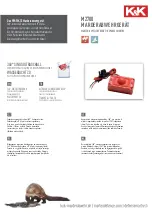
CHAPTER 2.0 Safety & EMC Instructions
2-10
CDS7324 (FORMERLY LSF-0819)
Rev. A
INSTALLATION & USER’S MANUAL
Flexible conduit or flexible multi-conductor cable shall be used where it is necessary to employ flexible
connections to pendant push-button stations. The weight of pendant stations shall be supported by means other
than the flexible conduit or the flexible multi-conductor cable, except where the conduit or cable is specifically
designed for that purpose.
Flexible conduit or flexible multi-conductor cable shall be used for connections involving small or infrequent
movements. They shall also be permitted to complete the connection to normally stationary motors, to position
switches, and to other externally mounted devices.
Connections to frequently moving parts shall be made with conductors suitable for flexing service in accordance
with European standard EN 60204-1. Flexible cable and flexible conduit shall be so installed as to avoid
excessive flexing and straining particularly at the fittings.
Cables subject to movement shall be supported in such a way that there is no mechanical strain on the
connection points nor any sharp bending. The loop shall have sufficient length to provide for a bending radius of
the cable of at least ten times its outside diameter.
Where cables subject to movement are close to moving parts, precautions shall be taken so that a space of at
least 25mm shall be maintained between the moving parts and the cables. Where this distance is not practicable,
fixed barriers shall be provided between the cables and the moving parts.
The cable sheath shall be resistant to the normal wear which can be expected from movement, and to the effects
of atmospheric contaminants (e.g. oil, water, coolants, dust).
Where flexible conduit is adjacent to moving parts, the construction and supporting means shall prevent damage
to the flexible conduit or cable under all conditions of operation.
Flexible metal conduit shall not be used for rapid or frequent movements, except when specifically designed for
that purpose.
j) Wiring Practices - Ducts, connection and junction boxes
All sharp edges, flash, burrs, rough surfaces, or threads, with which the insulation of the conductors may come in
contact, shall be removed from ducts and fittings. Where necessary, additional protection consisting of a flame-
retardant, oil-resistant insulating material shall be provided to protect conductor insulation.
Ducts and cable trays shall be rigidly supported and positioned at a sufficient distance from the moving parts and
in such a manner so as to minimise the possibility of damage or wear.
Cable trunking systems external to enclosures shall be rigidly supported and clear of all moving or contaminating
portions of the machine or equipment into which they are installed.
Содержание DS2110
Страница 15: ...CHAPTER 1 0 Overview 1 11 CDS7324 FORMERLY LSF 0819 Rev A INSTALLATION USER S MANUAL Page Intentionally Blank...
Страница 192: ...CHAPTER 5 0 Functional Overview 5 70 CDS7324 FORMERLY LSF 0819 Rev A INSTALLATION USER S MANUAL Page Intentionally Blank...
Страница 261: ...APPENDIX B GUI B 63 CDS7324 FORMERLY LSF 0819 Rev A INSTALLATION USER S MANUAL...
Страница 266: ...APPENDIX B GUI B 68 CDS7324 FORMERLY LSF 0819 Rev A INSTALLATION USER S MANUAL Page Intentionally Blank...
Страница 310: ...APPENDIX G ETHERNET MEZZANINE CARD G 9 CDS7324 FORMERLY LSF 0819 Rev A INSTALLATION USER S MANUAL...
















































